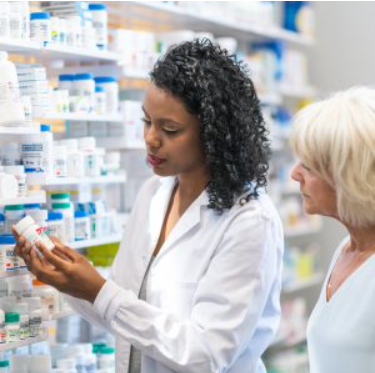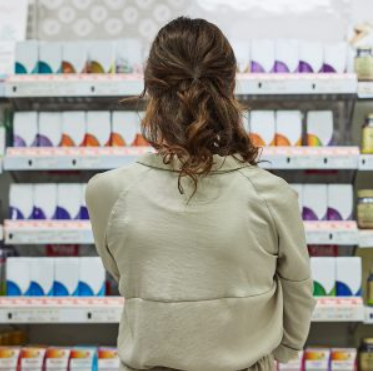A Guide to Patient-Centered Healthcare Packaging
The drug development process is complex while requiring significant resources and often years to advance an idea from a laboratory to a viable commercial product. The odds of success are not favorable.1 Despite the difficulty, drug therapies are a key component of our healthcare system that serve the needs of a patient or consumer.
Most of us will never know the names of the scientists, clinical researchers, or engineers who design the manufacturing process to consistently and effectively produce high-quality pharmaceuticals, including prescription or over-the-counter (OTC) medications, as well as vitamins and supplements. Aside from the intended health benefits of the product, the most impactful interaction we have with a product manufacturer is with the product’s packaging.
Jones Healthcare Group has been providing pharmaceutical packaging solutions for more than a century – it is part of our DNA.
While packaging design and development can vary significantly, experience has taught us there are several foundational elements that must be considered: the product journey, safety-stability-security and brand enhancement.
Central to each is the patient or consumer experience with the product at the end of the supply chain.
The Product Journey—Production to Patient or Consumer

The last leg of a drug product’s journey places it in the hands of a patient or consumer. Just before taking the recommended or prescribed dose, they must remove your product from its packaging. This means when designing packaging, it is important to visualize this “unpackaging moment,” while also considering the product’s distribution network after leaving the manufacturing facility. Here are some specific considerations:
• Will your packaging protect the product during transportation through a variety of environmental conditions? What will the product’s condition be when it reaches the patient or consumer? Consider an ICH stability program for temperate regions and conduct appropriate shipping studies to ensure products reach their destination without damage while maintaining product quality
• Will your product be dispensed by a pharmacist? Are the packages different enough to clearly communicate various dosages to help avoid dispensing errors? Text size, font, spacing, and readability all play a role in addition to color and brand names to help ensure dosing accuracy for the patient.
• Is your product used daily to treat a chronic condition? Bottling solutions can be used to provide 30, 60 or even several hundred doses, providing convenience to the patient over a month or two of treatment.
• Does your product require a high degree of dosing compliance? Blister pack solutions, which provide a visual reminder of a dose being removed, can also be printed with dates and other information to help improve medication adherence.
• Perhaps your product is used for acute, short-term conditions, such as acid indigestion. A single dose readily available in a convenience pouch or vial may be the best solution, particularly if the person is traveling.
• Is your medication used by older patients to reduce arthritis pain? Does the child resistance feature result in difficulties for seniors to open the product?
• Are your product’s prescribed dosing procedures complex and difficult for patients to understand? The key to answering this question lies in an understanding of your patient population. Innovative and intelligent, connected packaging solutions may drive better patient adherence, considering the growing adoption of smart devices to monitor health.
• Healthcare supply chain networks are global; however, a single, worldwide regulatory body does not exist. For packaging, that typically means specific labeling requirements based on geography. In some cases, these labeling requirements will drive packaging design.
These are just a few scenarios and with the patient population continuing to look for innovative solutions, you will likely think of many more.
The point is, consider your product’s distribution network, the journey it will take, and its condition when it arrives in the hands of the patient or consumer—and seek the right packaging solution that not only ensures product quality but also delivers an effective patient outcome.
Stability-Safety-Security

One of the more obvious elements considered when developing the right packaging for your pharmaceutical, vitamin, or supplement is the product itself. Healthcare products move through a rigorous development process to ensure they are safe and effective when they reach the end-user. After all, this is the primary function of packaging.
Pharmaceutical packaging has evolved with innovations that ensure product quality and stability after it leaves the manufacturing facility and moves through distribution channels before reaching the end-user. High barrier, flexible films and cold-form materials are used in blister packaging to protect the product from moisture and oxygen while offering a high degree of product count and combination creativity to enhance patient compliance. At the same time, many products can be packaged in economical, standard High-Density Polyethylene (HDPE) bottles with child-resistant caps, while adding desiccants and oxygen absorbers as required to ensure efficacy. All primary packaging methods should be considered and tested to determine the right solution for each product, market and patient population.
It is currently estimated that the size of the annual global counterfeit pharmaceutical market is greater than $200 billion.2 This figure does not include the damage done to brands when counterfeited versions of their products make it into the supply chain. For the healthcare industry, especially pharmaceuticals and OTC medications, the risks when counterfeit drugs reach patients are unconscionable and dangerous.
Many governments have enacted laws that require tracking pharmaceuticals as they move through the supply chain, giving significantly greater visibility into any potential product diversion that could lead to counterfeiting.
Additionally, tamper-evident packaging and labels can be used to provide the end-user with another layer of safety against potential adulteration. These packaging features focus solely on ensuring safety and security, providing the end-user with a greater level of trust in your product.
Brand Enhancement

Aside from your drug product performing as the patient or consumer expects, the most impactful interaction they have is with its packaging, which provides an important opportunity for your brand to deliver a positive experience.
A brand is not simply a name, logo, color scheme, or even that cool classic rock song that is used in commercial ads. All those things contribute to a brand, but it is the impression the user, patient, and consumer have of your product that defines your brand.
Did they struggle to open the packaging when they were half asleep, suffering from an intense headache? Your brand and its packaging may go right into the trash, literally. While that could be an extreme outcome, this scenario reinforces the importance that your product’s packaging must provide a positive experience.
The options for enhancing your brand using innovative packaging are countless. Consider the following example: a popular cold medicine comes in a night-time and day-time dose variant. Consumers can buy this OTC product in a single box that contains both dosage forms in blister packs. A single blister pack has both day and night-time doses, differentiated by their product color. This allows the consumer to throw a single blister pack in their pocket or bag for convenience.
The outcome: a packaging experience developed with the consumer in mind, which in turn creates a positive brand impression and dosing compliance.
This article is not intended to offer an answer to all the packaging questions that arise when considering how to deliver pharmaceuticals, vitamins and supplements to patients and consumers. It is intended to offer the starting point when beginning your package design process. Importantly, you should start your thinking at the end of the packaging value chain, with the person who is relying on your product. My recommendation is to consider the journey your product will take, its safety-stability-security and brand enhancement, all within the context of the patient and consumer experience.





